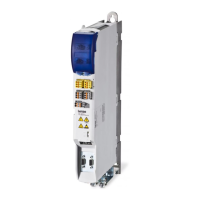Function library
Function blocks
9.2.40 Internal motor control (MCTRL)
9-140
L
EDSVS9332S-D11 EN 3.0
9.2.40.4 Speed controller
The speed controller is designed as an ideal PID controller.
Parameter setting
If you select a motor from the table in chapter 5.2 in C0086, the parameters are preset so that only
few adaptations to the application are necessary, if any.
z For setting parameters of the proportional gain Vp in C0070
– enter approx. 50 % of the speed setpoint
– increase C0070 until the drive becomes unstable (observe motor noises)
– reduce C0070 until the drive runs stable again
– reduce C0070 to approx. 50 %
z For parameter setting of the reset time Tn in C0071
– reduce C0071 until the drive becomes unstable (observe motor noises)
– increase C0071 until the drive runs stable again
– set C0071 to the double value
z For parameter setting of the derivative gain Td in C0072
– increase C0072 during operation until an optimum behaviour is achieved.
Signal limitation
When the drive outputs the max. torque, the speed controller operates within the limits.
z The drive cannot follow the speed setpoint.
z This state is indicated with MCTRL-MMAX = HIGH.
Setting the integral component
To enter defined starting values for the torque the integral component of the n-controller can be set
externally (e.g. when using the brake control).
z MCTRL-I-LOAD = HIGH
– The n-controller accepts the value at input MCTRL-I-SET as its integral component.
– The value at input MCTRL-I-SET acts as a torque setpoint for the motor control.
z MCTRL-I-LOAD = LOW
– Function is switched off.

